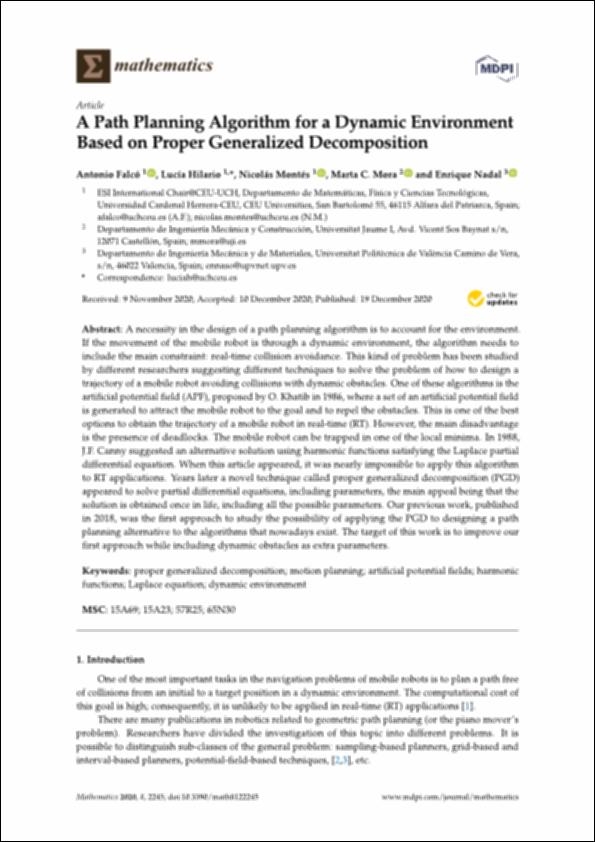Please use this identifier to cite or link to this item:
http://hdl.handle.net/10637/12722A path planning algorithm for a dynamic environment based on proper generalized decomposition
| Title: | A path planning algorithm for a dynamic environment based on proper generalized decomposition |
| Authors : | Falcó Montesinos, Antonio Hilario Pérez, Lucía Montés Sánchez, Nicolás Mora Aguilar, Marta Covadonga Nadal Soriano, Enrique |
| Keywords: | Autómatas matemáticos, Teoria de.; Machine theory.; Robotics.; Robótica.; Differential equations, Partial.; Descomposición (Matemáticas); Decomposition (Mathematics); Funciones armónicas.; Harmonic functions.; Ecuaciones en derivadas parciales. |
| Publisher: | MDPI. |
| Citation: | Falcó, A., Hilario, L., Montés, N., Mora, M.C. & Nadal, E. (2020). A path planning algorithm for a dynamic environment based on proper generalized decomposition. Mathematics, vol. 8, i. 12 (19 dec.), art. 2245. DOI: https://doi.org/10.3390/math8122245 |
| Abstract: | A necessity in the design of a path planning algorithm is to account for the environment. If the movement of the mobile robot is through a dynamic environment, the algorithm needs to include the main constraint: real-time collision avoidance. This kind of problem has been studied by different researchers suggesting different techniques to solve the problem of how to design a trajectory of a mobile robot avoiding collisions with dynamic obstacles. One of these algorithms is the artificial potential field (APF), proposed by O. Khatib in 1986, where a set of an artificial potential field is generated to attract the mobile robot to the goal and to repel the obstacles. This is one of the best options to obtain the trajectory of a mobile robot in real-time (RT). However, the main disadvantage is the presence of deadlocks. The mobile robot can be trapped in one of the local minima. In 1988, J.F. Canny suggested an alternative solution using harmonic functions satisfying the Laplace partial differential equation. When this article appeared, it was nearly impossible to apply this algorithm to RT applications. Years later a novel technique called proper generalized decomposition (PGD) appeared to solve partial differential equations, including parameters, the main appeal being that the solution is obtained once in life, including all the possible parameters. Our previous work, published in 2018, was the first approach to study the possibility of applying the PGD to designing a path planning alternative to the algorithms that nowadays exist. The target of this work is to improve our first approach while including dynamic obstacles as extra parameters. |
| Description: | Este artículo se encuentra disponible en la siguiente URL: https://www.mdpi.com/2227-7390/8/12/2245 Este artículo pertenece al número especial "Computer aided geometric design". |
| URI: | http://hdl.handle.net/10637/12722 |
| Rights : | http://creativecommons.org/licenses/by/4.0/deed.es |
| ISSN: | 2227-7390 (Electrónico). |
| Issue Date: | 19-Dec-2020 |
| Center : | Universidad Cardenal Herrera-CEU |
| Appears in Collections: | Dpto. Matemáticas, Física y Ciencias Tecnológicas |
Items in DSpace are protected by copyright, with all rights reserved, unless otherwise indicated.


